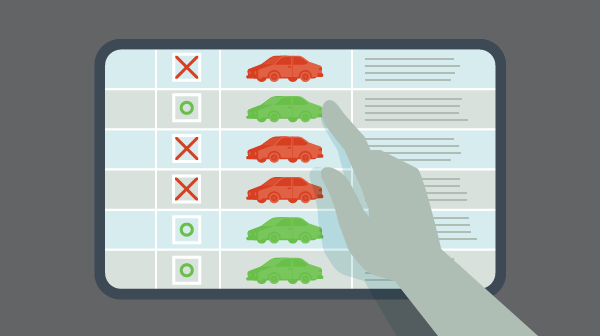It has been more than a hundred years since cars first became available to the masses, and a lot has changed in automotive since then. The vehicles themselves and how they are sold has matured significantly – fueled by new technologies. As more models hit the market every decade, and one-car families turn into two- or three-car households, it has become more difficult for dealers to anticipate customer needs. In some ways, the rise of e-commerce and the shift in customer expectations that’s come with it has made selling to customers even more challenging.
While a lot with the industry has changed, the need to cater to customers to move metal has remained a common denominator for dealership success – even if the customers themselves and the inventory have evolved considerably. In a highly connected world, technology can help dealers overcome today’s unique market challenges, and even accommodate selling with more precision and success than ever before in auto retail history.
Challenge #1: Getting to Know Your Customers
Customers come in all shapes and sizes and looks can be deceiving when it comes to predicting their needs. According to the Cox Automotive and VinSolutions Technology and the Transformation of Retail Study, 76 percent of consumers expect a dealer to know at least something about them before they step foot into the showroom. A connected CRM can help you to understand key customer information like the trade-in value of their current vehicle, budget, purchase and browsing histories. By aggregating this data from third-party sites, which Cox Automotive Car Buyer Journey study finds are the most-used sites for car shopping, you can execute a tailored and deliberate sales approach and a positive customer experience.
For example, a customer with a history of sedan ownership may come into a showroom claiming only to be interested in looking at more sedans. However, their browsing history reveals some recent research on SUVs. With this background information in hand, dealers can bridge the gap between what customers say they want and what their actions show they want. Perhaps the dealer suggests a crossover that offers the best of both worlds to this customer, even if the customer didn’t submit a lead on that particular vehicle.
This kind of advisory relationship is what customers value from dealers, with 62 percent of respondents in the Cox Automotive and VinSolutions Technology and the Transformation of Retail Study, saying they want a more trusting dealer relationship. The dealer, armed with the right information, closes the sale and gets a return customer thanks to the sophistication of service. On the other hand, the dealer without the relevant information wastes time and frustrates the customer, therefore making it more likely they lose the sale and any repeat business.
While knowing your customer and their needs is an advantage when they step into the dealership, CRMs can be just as powerful for attracting them to your business in the first place. Part of the customer challenge today is capturing their attention, to begin with, and almost anyone with phone or email capabilities is flooded with irrelevant offers that do more to push the recipient away than to draw them in. With the specific, relevant customer details that a powerful CRM can provide, dealers can create customized marketing communication that targets the right customer at the right time, which is proven to increase lead-to-sale conversion rates.
Challenge #2: Executing an Inventory Strategy
Knowing your customer is crucial for initiating a sale, but having the right inventory is crucial to closing it. Previously, dealers were able to get by based on a reading of their marketplace, past sales data, customer feedback, and in the case of the franchise dealer, advice from the OEM. However, new-car sales margins are shrinking, with new-vehicle sales down 11.3 percent YOY in September, according to the Cox Automotive October 2019 Industry Update. This makes it increasingly important for dealers to execute an efficient used inventory strategy that reduces holding costs, maximizes profitability, and fosters positive customer relationships.
Supply-and-demand for used vehicles is equally high, and margins are razor-thin. The situation is further complicated by the $32-a-day cost to hold an unsold vehicle, so it is very important to stock with the goal of turning vehicles at lightning speed. The best way to do this is to match specific cars with specific buyers in real-time. This buyer-centric strategy may sound easier said than done, but an integrated CRM removes the guesswork and allows dealers to appraise with specific buyers in mind.
With the right technology, dealers can receive notifications when a vehicle their appraising fits the criteria of what a customer is looking for. Dealers can stock with confidence, knowing they already have a potential buyer for a vehicle. Moreover, the same systems give dealers a birds-eye view of active leads on a vehicle in their inventory, making it easier to price the car according to real-time demand. With over half of respondents in the Cox Automotive Car Buyer Journey study, revealing they were dissatisfied with the duration of the sales process, it’s in every dealer’s best interest to streamline steps when possible. With on-demand pricing, negotiations can get streamlined and become more transparent. This creates a more reliable sales experience they are likely to repeat in the future.
With the right tools, a daunting auto retail market can turn into an unprecedented sales opportunity. To maximize the moment and technology, dealers need to embrace their CRM and its many system capabilities. Above all, successful dealers will adopt a buyer-centric attitude where their stocking and sales approach is informed by customer data — not the other way around. Successfully deploying a connected CRM, enables dealers to enter an age focused solely on selling, not speculating.
A version of this article originally appeared in Digital Dealer.


